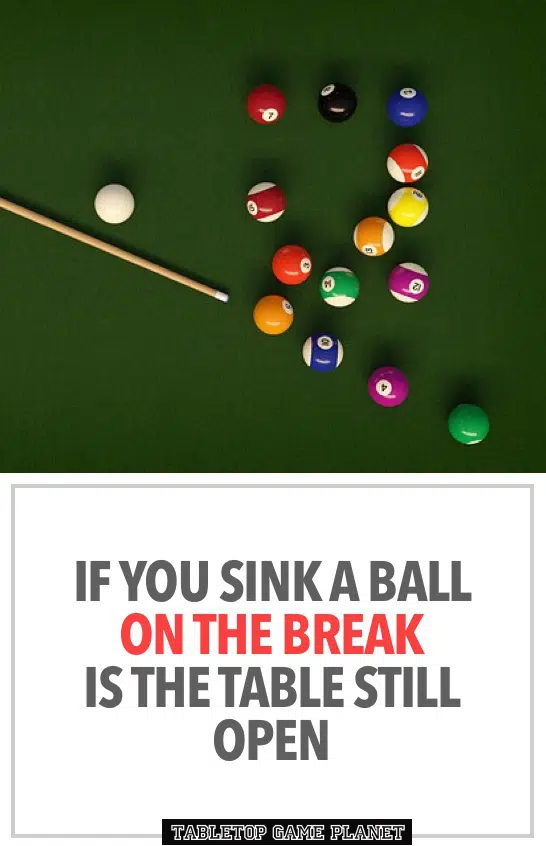When breaking the rack in pool, the Cue Ball is placed behind the service line, and a player needs not hit any object ball in particular. If a breaker fails to pocket any ball, at least four balls should hit the cushion for the break to be considered legal.
The breaker should strike the racked balls with the Cue Ball using enough force to open up the table. Poor shots that fail to break the rack, or a scratch foul is committed on the break, a rerack is taken, and the same player who took a break has to restart the game.
So, if a player sinks a ball on the break, is the table still open? Yes, the table is considered open once a break is done, even when a ball gets pocketed. As a result, no ball type has been designated on the break.
Playing stripes or solids will be determined when the first player legally pockets one of the object balls.
When a player sinks any object balls during the break, the shooter continues to shoot either ball type, unless they scratch in the process.
If the breaker fails to pocket any object balls on the break, the gameplay passes over to the opponent player, who has to take their shot wherever the white ball lies on the pool table.
If the opener scratches on the break, the opponent player earns a ball in hand, and they are free to move a Cue Ball anywhere they want behind the baulk line. When the 8-ball gets pocketed, according to official rules, a player should return it to the table, and ball in hand applies.
Whichever ball sunk on the break, the table remains open and a player must make a legal shot after the break in order to close the table. Answered below are frequently asked questions about sinking a ball on the break and why the table is still open.
What happens if you sink a ball on the break?
It depends on which ball sunk on the break. When a player sinks any object ball apart from the white or black ball on the break, the shooter continues to shoot.
When both types of balls get pocketed, the shooter can decide the ball type they want to continue playing with, but they have to sink another ball of the suit in order to close the table.
When a player sinks the Cue Ball on a break, that’s a foul, and the shooter has to forfeit their turn. The upcoming player gets the ball in hand behind the serving line and they can’t shoot backwards.
When the black ball sinks on the break, the ball is returned to play on the rack dot and the next player will earn ball in hand behind the baulk line, or the guilty player can ask for a rerack.
However, when APA rules are used, sinking the black ball on the break can lead to automatic loss when a player scratches the process or a win when the white ball remains in play.
Either way, the table remains open when a ball sinks despite the ball type that sunk.
How do you sink a ball on a break?
All the balls are arranged inside a rack on a break with the black ball at the center on the rack dot. The Cue Ball is placed behind the service line, and it is shot straight on the rack with strong force to distribute the balls around the pool table.
For a legal break to count, four balls must contact the bumper cushion on the side of the table. When driving the Cue Ball, the player should focus mostly on the ball on the second row to transfer all the energy with explosive contact.
The black ball will distribute the object balls evenly to increase the chances of sinking. The ball moves randomly along the cushion after the break, and ball get pocketed when the force is great enough to spread them out.
When any object balls get to the pocket, the breaker will continue shooting until they fail to sink their subsequent turns. The sunk ball will determine which ball type each player will continue shooting during the game.
However, if they fail to sink any ball after the break, the gameplay is passed to the other player, who could have an opportunity to sink any strategically positioned ball because the table is still open.
What are the rules for breaking in pool?
Breaking can vary depending on the house rule applied during the break. The following are a set of rules to be followed on the break, especially in professional tournaments and gameplay settings:
- A legal break is considered when the Cue Ball drives at least four balls into the cushion without the white ball going into a pocket.
- A table is declared open once the shooter makes a break, regardless of which ball gets sunk.
- When the Cue Ball sinks during a break, that’s a scratch, and the turn is passed to the opponent player.
- During the break, the opponent player earns a ball in hand behind the head string, and the opponent player is restricted to placing the Cue Ball behind the service line. The white ball must pass the line before contacting any ball in play.
- When a black ball gets sunk during the break, a player must return the ball to the gameplay, or the player who took the break can request a rerack for the second break opportunity. If they don’t, the opponent player earns a ball in hand behind the line. However, some house rules (and APA rules) for sinking the ball on the break can lead to an automatic win or loss if the white ball sinks too.
- When the breaker sinks any object ball on the break, the player can continue shooting the ball type similar to the pocketed ball as long as they don’t scratch. If they fail, the gameplay is passed to the opponent player and the table is still open.
- Players can toss a coin to determine who breaks first during the first game, but players shift their turns in sequential matches based on who wins.

Sinking Ball on Break in Pool: Conclusion
The player must start a pool game by taking a break on the racked balls. Once the rack has been broken, the table is open, and it doesn’t matter which ball gets sunk.
A player should take a break shot with a lot of force to make a perfect distribution of the balls. A break without driving at least four balls against the cushion is not legal and the balls should be reracked.
The breaker should target the ball on the second row adjacent to the black ball for a perfect shot to increase the chances of sinking at least one ball on the break.
House rules, particularly on the break issue, vary from place to place, so always agree with the opponent player on the set of rules that need to be followed regarding the opening break. For instance, some versions regard pocketing the 8-ball as an automatic win or lose if a scratch foul is committed, but others, a foul on the black ball on the break, are treated as a normal foul and ball in hand behind the service line suffices.
